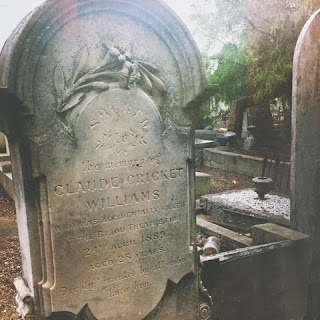Melbourne General Cemetery, Australia
by Samantha Kent
 My interest in photographing historic cemeteries began in
August 2015 and has turned me into a serious taphophile and admirer of
ironwork and stonemasonry. The beauty and history leaves me in awe and I have
to make sure I have at least two hours to explore each cemetery because I get
so enthralled in what I find. The majority of the cemeteries I have explored
and photographed have been in and around my home town of Brisbane, Australia
but recently on a trip to Melbourne, Australia I made a visit to the Melbourne
General Cemetery and within minutes of
being there it became my current favourite historic cemetery! I adore the
statues and crosses within the grounds with most still in excellent condition
despite being decades old.
My interest in photographing historic cemeteries began in
August 2015 and has turned me into a serious taphophile and admirer of
ironwork and stonemasonry. The beauty and history leaves me in awe and I have
to make sure I have at least two hours to explore each cemetery because I get
so enthralled in what I find. The majority of the cemeteries I have explored
and photographed have been in and around my home town of Brisbane, Australia
but recently on a trip to Melbourne, Australia I made a visit to the Melbourne
General Cemetery and within minutes of
being there it became my current favourite historic cemetery! I adore the
statues and crosses within the grounds with most still in excellent condition
despite being decades old. Melbourne General Cemetery was opened in 1852 covering 43
hectares (106 acres) and is now considered one of the most important and
historically significant cemeteries in Australia. The cemetery has different
sections including chapels, gardens, 3 mausoleums added in the 1990’s, and
religion sections specifically for individuals of different faiths including
Church of England, Roman Catholic, Baptists, Methodist and Presbyterian. The
cemetery holds several notable interments including Prime Ministers, Premiers,
explorers and entertainers. The cemetery holds 300,000 burials which will mean
several more visits by me in future.
Melbourne General Cemetery was opened in 1852 covering 43
hectares (106 acres) and is now considered one of the most important and
historically significant cemeteries in Australia. The cemetery has different
sections including chapels, gardens, 3 mausoleums added in the 1990’s, and
religion sections specifically for individuals of different faiths including
Church of England, Roman Catholic, Baptists, Methodist and Presbyterian. The
cemetery holds several notable interments including Prime Ministers, Premiers,
explorers and entertainers. The cemetery holds 300,000 burials which will mean
several more visits by me in future.  |
| Claude Cricket Williams' headstone |
 On this visit I came across several graves of interest. The
first is that of Claude Cricket Williams. Claude’s grave inscription says he
was “accidentally killed at the Bijou Theatre fire in 1889.” He was 28 years of
age. My research has revealed that Claude was the hall porter at the theatre
and Claude died along with Captain Parsons, 33 years old, of the East Melbourne
Brigade. The inquest found that there was “abundant evidence to show that both
men came by their deaths through disobedience of order.” In Captain Parsons’ case, he was with a group of fire fighters who placed a ladder over a narrow
gangway in an attempt to get onto the stage. Despite being warned by others
that the walls could be heard cracking from the heat, the men proceeded with the
ladder until the east wall gave way, striking Parsons in the head. In the case of Claude it was deemed he stayed
in the burning building in an attempt to assist with the fire “without any
right as he was not a member of the fire brigade.”
On this visit I came across several graves of interest. The
first is that of Claude Cricket Williams. Claude’s grave inscription says he
was “accidentally killed at the Bijou Theatre fire in 1889.” He was 28 years of
age. My research has revealed that Claude was the hall porter at the theatre
and Claude died along with Captain Parsons, 33 years old, of the East Melbourne
Brigade. The inquest found that there was “abundant evidence to show that both
men came by their deaths through disobedience of order.” In Captain Parsons’ case, he was with a group of fire fighters who placed a ladder over a narrow
gangway in an attempt to get onto the stage. Despite being warned by others
that the walls could be heard cracking from the heat, the men proceeded with the
ladder until the east wall gave way, striking Parsons in the head. In the case of Claude it was deemed he stayed
in the burning building in an attempt to assist with the fire “without any
right as he was not a member of the fire brigade.” |
| A "Father" of the Australian Labour Day |
The second grave I came across is that of James Stephens who the founder of the “8 hour system” in Victoria, Australia. James was a stonemason, Trade union official and Chartist who on 21 April 1856 lead a group of stonemasons who walked off the job demanding the 8 hour system (8 hours of work, 8 hours of recreation, 8 hours of sleep) be introduced in Victoria, with the same pay. The movement worked and a public holiday called “Labour Day” is now held every year to remember this achievement.
This grave really caught my eye because it is the grave of a local undertaker, John Allison. I look forward to my next visit and what other stories I will find.
**************************************
Check out Samantha's photographs on Instagram. Just click that link and log on with your Facebook ID (if you're not already on Instagram). Cut and paste Samantha’s Instagram identifier into the search box: "sammy_eternityandchurch_pics." Please visit and enjoy her work!
Sources:






Seems like a harsh determination for Claude; he was trying to help! :-) Nice images.
ReplyDelete